In this Article
Toggle
From the north, where the aptly named Tennessee River winds its way horizontally across the map creating a border between Alabama and Tennessee, to where the Cotton State meets the Gulf of Mexico, there are eight Alabama bird trails. Combined they offer a glimpse at more than 430 species of birds at 280 stops along the trails. From Orange Beach to Fort Morgan, these are some of the birds in Alabama to watch for when you visit the Gulf Coast region in the southern part of the state.
To help offset the costs of running EverydayWanderer.com, you’ll find affiliate links lightly sprinkled throughout the site. If you choose to make a purchase via one of these links, there’s no additional cost to you, but I’ll earn a teeny tiny commission. You can read all of the legal blah blah blah (as my little niece says) on the full disclosure page.
Sage Advice: This article is designed to give the average traveler a high-level overview of the common birds often seen along the Alabama Coastal Birding Trail. Download this birds of the Gulf Coast region checklist courtesy of the Alabama Department of Conservation and Mobile Bay Audubon Society for a more comprehensive register and to keep track of the birds you see.
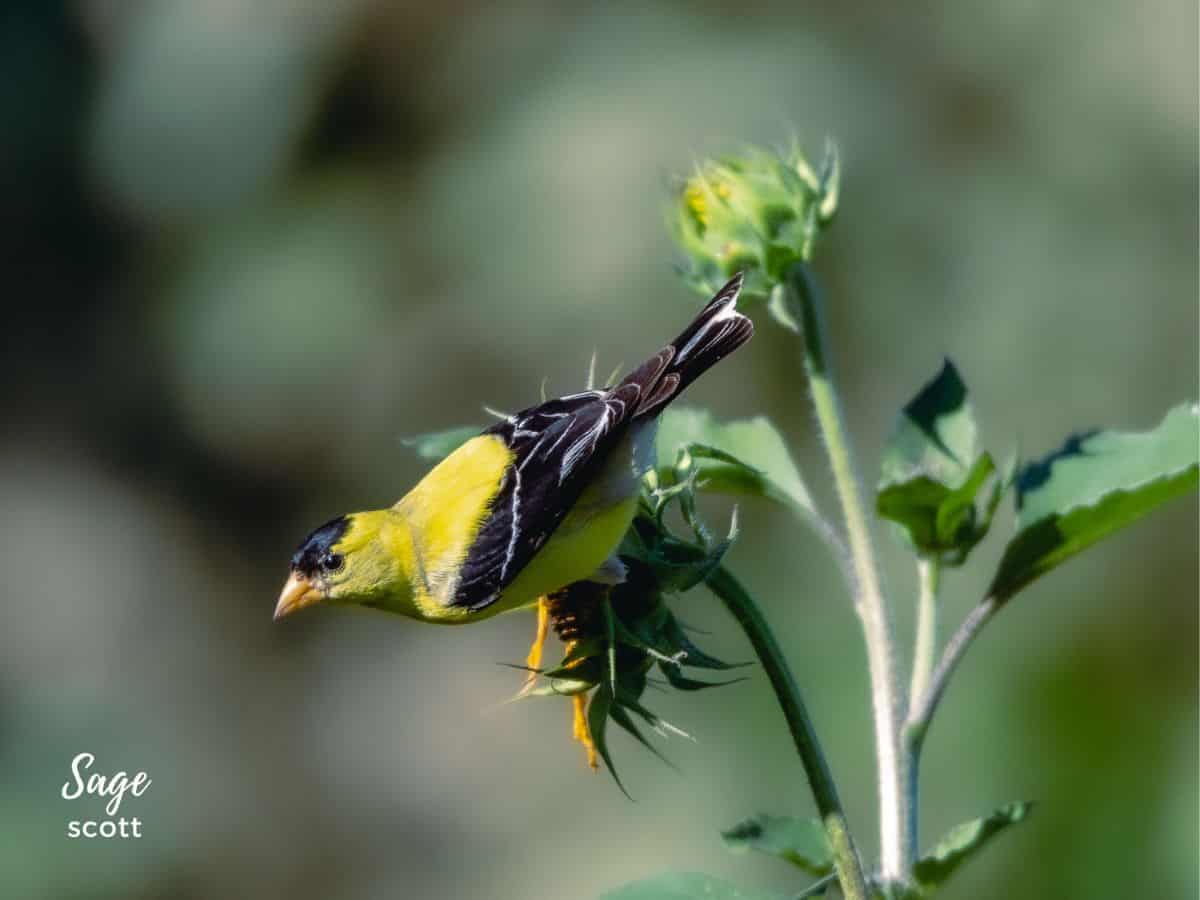
American Goldfinch
With its lemon-colored body, it’s easy to understand why the American goldfinch is also known as a wild canary. But while domestic canaries are typically solid yellow, goldfinches are yellow birds with black and white accented wings. Although American goldfinches can be found in all 48 of the continental states, those living in northern regions migrate south for the winter. So you’re likely to find these warblers year-round along the Alabama bird trail.
Fun Fact: The American Goldfinch is the official state bird of three states: Iowa, New Jersey, and Washington.

Barn Swallow
About the size of a bluebird, barn swallows have steel blue wings, a downy underbelly, and a rust-colored throat. These feathered friends eat on the run, catching most of their food while in flight. And the insects barn swallows love most — like mosquitoes, flies, gnats, and flying termites — are often the most hated by humans. You can most commonly find these birds in Alabama in the spring, summer, and fall.

Barred Owl
Also known as a hoot owl, barred owls are typically found east of the Mississippi River, from Canada to the Gulf of Mexico. Despite the wide variety of temperatures that range covers, barred owls typically do not migrate. Therefore, you can look for these birds along the Alabama bird trail year round. Although barred owls look cute and cuddly with their soft grey faces, they are skilled hunters who feast on small mammals like field mice, bats, squirrels, and rabbits.

Blue Jay
Resting over a cream-colored belly like a cloak fastened around the bird’s neck with a jet black ribbon, a blue jay’s feathers range in color from turquoise to lapis. They typically feast on seeds and nuts, using their strong black beak to crack open acorns and peanuts.
When visiting the Alabama bird trail, don’t just keep an eye out for blue jays, keep an ear out, as well. You’ll likely hear them verbally mimic the scream of hawks to shoo smaller birds away from food sources.

Blue-Gray Gnatcatcher
Blue-gray gnatcatchers look a bit like a middle-aged bluebird whose feathers have turned gray with age. This unassuming bird works overtime ridding the Gulf Shores of pesky insects like flies, wasps, and spiders. Although blue-gray gnatcatchers can be found in most areas of the United States (except in the Rocky Mountain and Pacific Northwest), they are not that common. However, during the fall migration, they flock to the Gulf Shores region in large numbers.

Brown Pelican
No visit to the Gulf Shores is complete without seeing a small formation of brown pelicans flying low over the water and suddenly dive bombing into the surf to scoop up fish. When it does, a brown pelican will fill its throat pouch with more than two gallons of water and anchovies, herring, and other small fish that hang out near the surface. Because brown pelicans feast on fish, you’ll find these water birds in Alabama along the coastline and the inshore waters.
Sage Advice: Once you’ve had your fill of birds along the Alabama bird trail, see more Gulf Coast wildlife with a dolphin cruise.
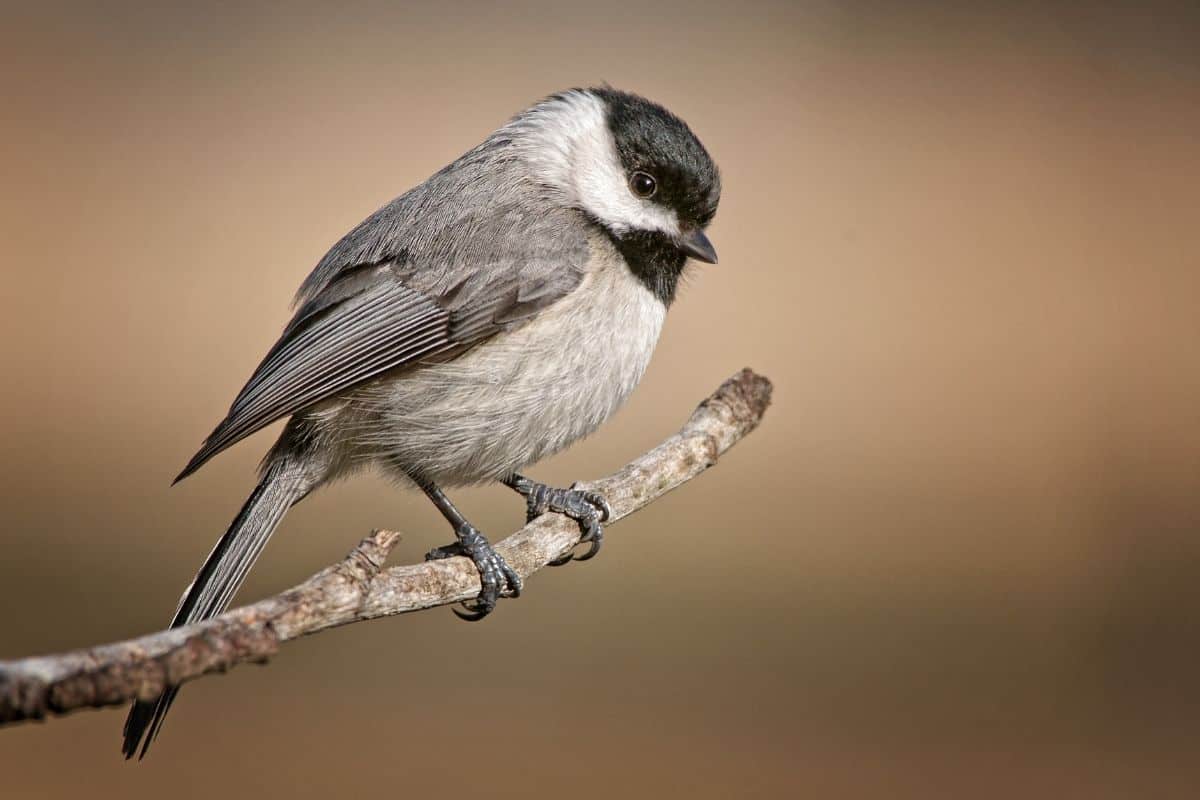
Carolina Chickadee
These small, cream-breasted birds have a black forehead and throat. Keep an eye out for these grayish birds in Alabama when exploring wooded areas where they’re likely to be feasting on insects in the tree bark and among the leaves. Carolina chickadees are also frequent visitors to backyard feeders.

Ducks Like Mallards, Mergansers, and Wood Ducks
To move past mallards, watch for mergansers like the common, hooded, or red-breasted varieties. With its elaborate crest, the hooded merganser reminds me of Priscilla Presley during her beehive hairdo phase.

And if mallards and mergansers are a colorful patchwork of plumes, wood ducks are an elaborate mosaic of carefully fitted feathers topped with a Trojan war helmet.

When watching for mallards, mergansers, wood, and other members of the duck family look in and around the water in Alabama where they feast on aquatic insects and small fish.
Related Article: 100+ Duck Quotes That Will Quack You Up
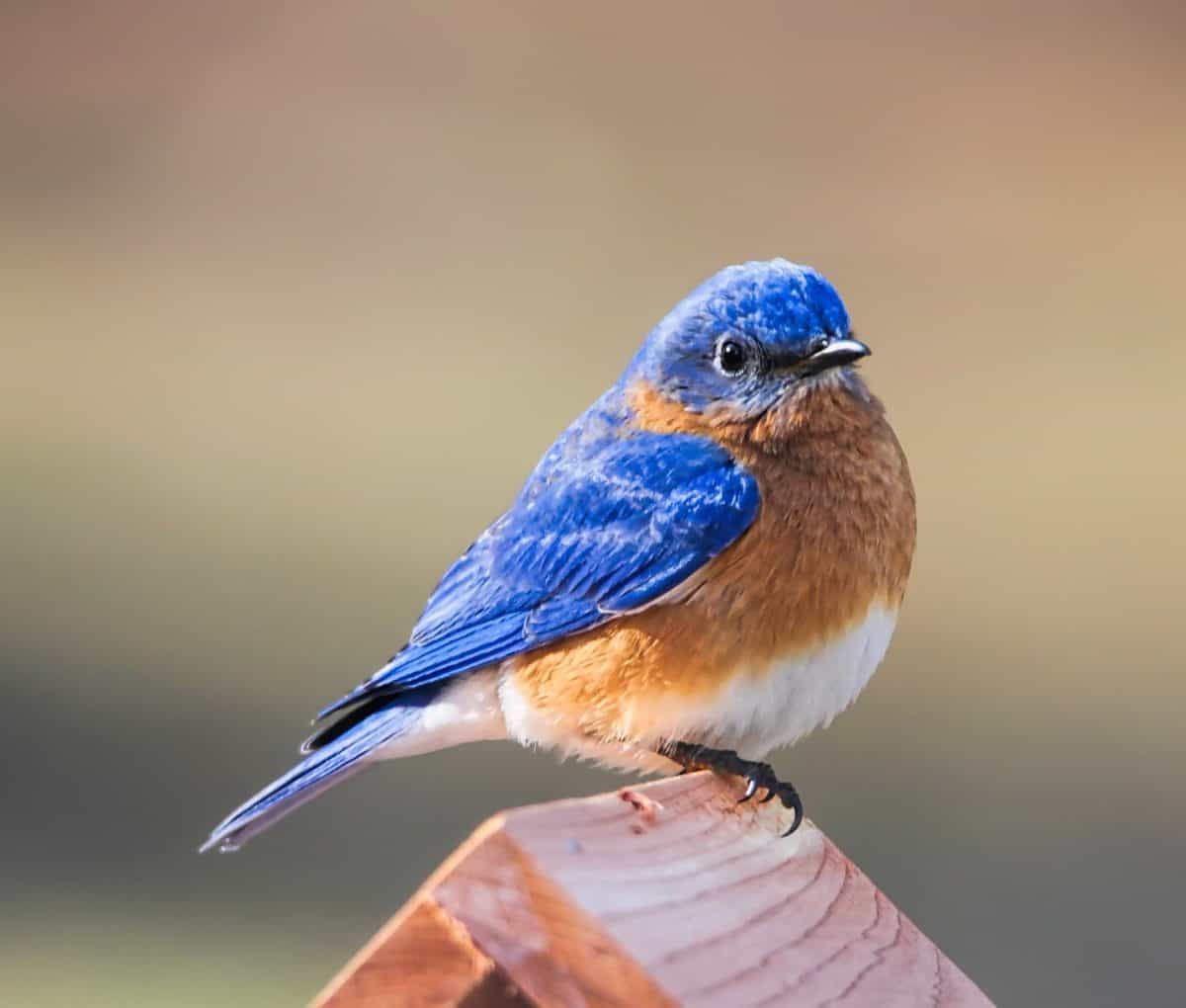
Eastern Bluebird
With a rust-colored breast and bright blue cap, wings, and tail, Eastern bluebirds are aptly named since they are commonly found east of the Rocky Mountains. And in Alabama, you’re likely to see Eastern bluebirds year-round.
In addition to grubs, worms, and insects, Eastern bluebirds enjoy feasting on fruit, so look for them in peach, plum, apple, and other fruit trees across Alabama.

Eastern Kingbird
Birds with “eastern” in their name are typically found east of the Rocky Mountains. However, the Eastern kingbird likes to break that rule. These grey-scale songbirds make their homes across the US, from the Atlantic to the Pacific. You’ll find these birds in Alabama along the Gulf Coast, specifically on the beaches and sand dunes.

Eastern Phoebe
Another unassuming bird, the Eastern phoebe is a songbird that can be found along Alabama’s Gulf Coast most seasons except summer. Look for them away from the sand and surf, keeping an eye out in deciduous woodlands instead.
Fun Fact: Eastern phoebes were the first birds to be banded in North America back in the early 1800s. Nature-loving John James Audubon tied silver threads to the legs of Eastern phoebes and used the markers to identify the birds that returned to his Pennsylvania home each year.

Great Blue Heron
With long skinny legs and necks and wide wingspans, great blue herons have always reminded me of modern-day pterodactyls. Also known as cranes or egrets, look for great blue herons in shallow bodies of water like marshes, swamps, and tidal flats.
You’re likely to see these water birds in Alabama wading knee-deep in search of crayfish, salamanders, snakes, and even unattended buckets of bait fish. Despite its name, the great blue heron is more slate-colored than blue-hued, with a black stripe running from the tip of its sharp bill to the top of its spine.

Green Heron
There are two types of herons commonly found along the Alabama coastal birding trail, great blue herons and green herons. If you’re expecting a green heron to be an emerald or olive version of a great blue heron (like I was), you’ll be sorely disappointed. Although they have similarly long pointed beaks and piercing yellow eyes, that’s where the similarities end. Compared to great blue herons, green herons have short legs and a crow’s length neck.

Great Egret
Unlike the green heron, the great egret more closely resembles the silhouette of a great blue heron, albeit a snowy-white rendition. Look for these large white birds in Alabama waters year round in the inland coastal plain and Gulf Coast regions of the Alabama bird trail.
Fun Fact: The adult great egret is the largest white heron found east of the Rocky Mountains.

Hawks Like Cooper’s Hawks and Red-Tailed Hawks
While many birds on this list help keep Alabama’s insect population in check, the hawks found along Alabama bird trail keep the rodent population in check. And as someone with a paralyzing fear of mice, this is a very, very good thing!
Because hawks feed on small mammals rather than fish, look for them in the wooded areas of Alabama’s Gulf Coast. While exploring the Gulf Shores bird trail, keep an eye out for two specific types of hawks: Cooper’s Hawk and Red-Tailed Hawk. Both are keen hunters with sharp hooked beaks and strong talons, and both have a mix of cream- and chocolate-covered feathers. However, the red-tailed hawk is the largest hawk in Alabama, and male adults will have rust-colored tail feathers.

Indigo Bunting
Also known as blue canaries, indigo buntings are some of the prettiest blue birds in Alabama. However, because they typically winter in the Caribbean or Central and South America, they’re most commonly spotted along the Alabama bird trail in the summer months. They are quite chatty, singing from dawn to dusk, and are most commonly found in fields full of tall grass and shrubs near trees.

Killdeer
These doe-eyed birds look like a cross between a pigeon and a seagull. And despite the ferocious-sounding moniker that suggests these Gulf Shores birds regularly attack Bambi, killdeer are named for their loud cry that sounds like “kill-dee,” “kill-deer,” or “kill-deeah.” Killdeer are very popular birds in Alabama, and you’ll likely find them in pastures, fields, and near the water. One of the easiest ways to identify a killdeer is by the two horizontal black stripes that accent its white breast like a necklace.

Laughing Gull
If you spend at least five minutes outside enjoying Alabama’s beautiful Gulf Coast region, you’re sure to spot a laughing gull. These white-breasted, grey-winged, and black-accented Gulf Coast birds are commonly spotted in and around the Gulf of Mexico as well as on the area’s beaches, lakes, and rivers.

Mourning Dove
Some of the birds in Alabama along the Gulf Shores birding trail are far from exotic. We’ve already talked about the commonplace (but very cute) mallard, and now let’s chat about mourning doves. You’re likely to hear the mournful coo of these sandy brown birds all over the Yellowhammer State, but you’re most likely to spot them in open fields, woodland clearings, and residential areas.
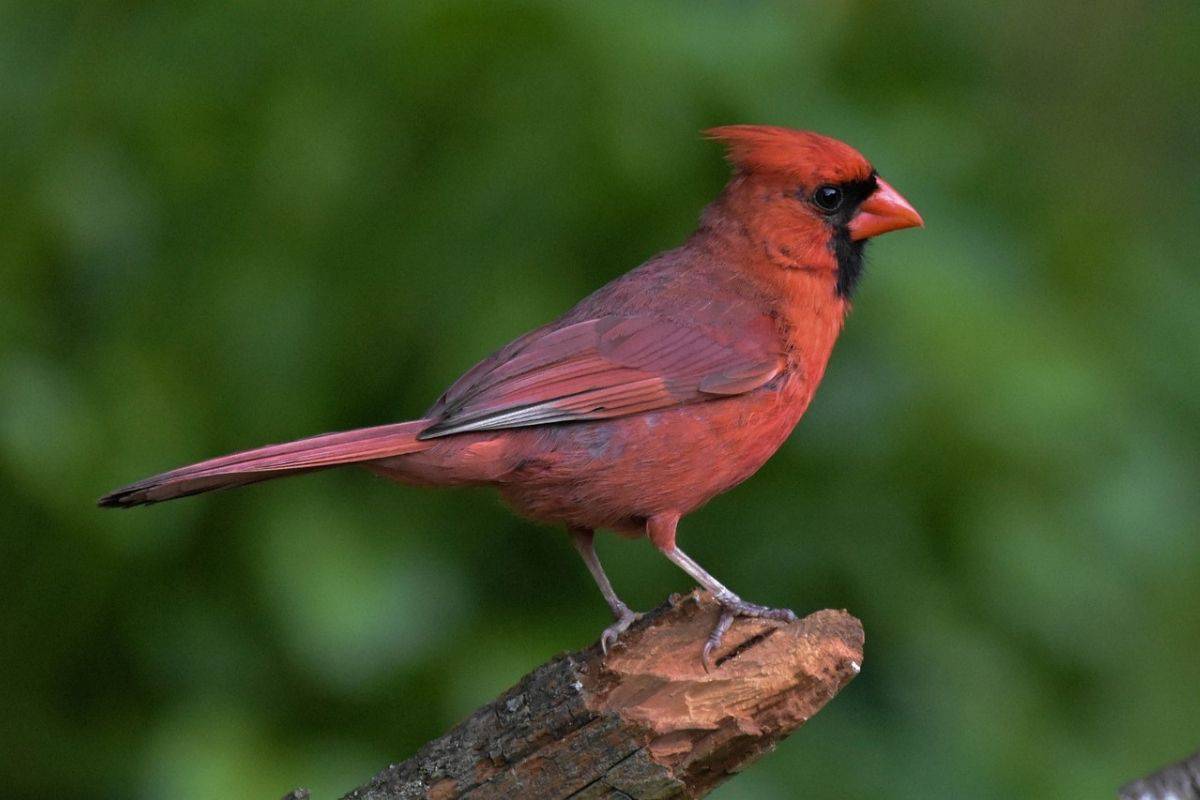
Northern Cardinal
With bright red feathers, black mask, and Mohawk-like crest, cardinals are easy to spot along the Alabama bird trail. Like elsewhere in North America, these songbirds feast on seeds, grains, insects, and berries in Alabama, so look for them along hiking trails and in residential areas.
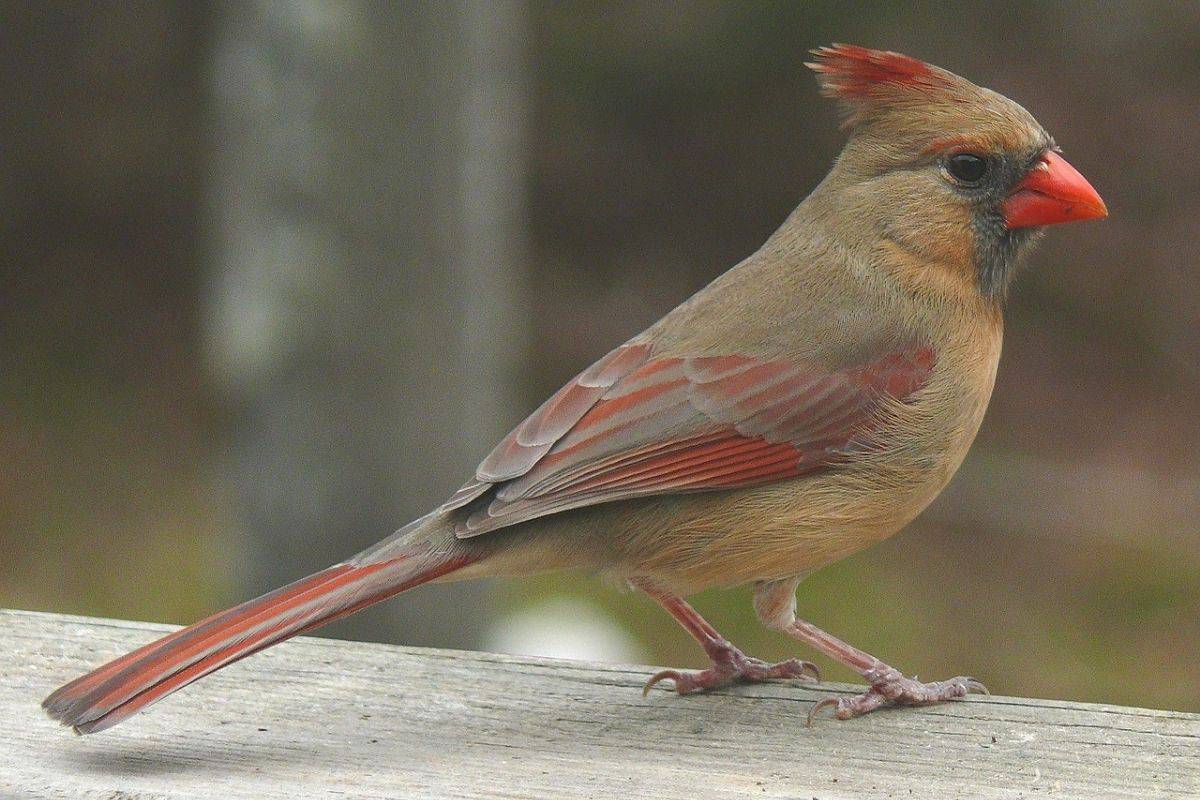
In the bird world, as well as elsewhere in the animal kingdom, females are typically more subdued than the males. Just look at the peacock. Or the male. And while that’s true for the Northern cardinal, I do find the females to be a bit less mousy than usual.

Northern Mockingbird
The Northern mockingbird is a songbird that looks a bit like a grey-scale sparrow. Because mockingbirds don’t migrate, they can be found along the Alabama coastal birding trail year round. Mockingbirds feast on insects, so they are commonly found in freshly-mowed lawns and fields.

Purple Martin
About the size of a robin, purple martins are the largest species of swallow found in North America. Like many birds in the animal kingdom, female purple martins are rather plain-looking. But male purple martins have distinct iridescent purplish-blue feathers that help you spot them in Alabama’s open and wooded areas.
In addition to looking marvelous, purple martins enjoy eating wasps, mosquitoes, and other flying insects that annoy humans.

Red-Winged Blackbird
Almost entirely jet black, the red-winged blackbird has a crimson patch underlined in mustard on each wing. And if the red-winged blackbird reminds you a bit of a less-colorful oriole, that is likely because they are cousins in the animal kingdom. You’re likely to find these common Alabama songbirds all along the Gulf Shores bird trail, from fields to marshes and swamps.

Rose-Breasted Grosbeak
Of all the red-breasted birds found around the world, the rose-breasted grosbeak is one of the coolest (at least in my opinion). While American robins, house finches, and other red-breasted birds typically have a chest full of ruby feathers, the grosbeak is different. Its red breast is smaller than other birds, surrounded by a sea of soft white elsewhere on its breast and a face of ebony feathers. These Alabama birds are most commonly spotted in the spring and fall.

Roseate Spoonbill
While cardinals, doves, and mallards are commonly found all over the United States, the salmon-colored spoonbill is one of the more unique Gulf Shore birds that most visitors hope to see along the Alabama bird trail. Hugging the northern coast of the Gulf of Mexico, roseate spoonbills make their homes from Texas to Florida. While they can be tough to spot these large birds in Alabama, your best chance is in summer and fall. Look for these wading birds in bays, inlets, and marshes as well as on beaches.

Ruby-Throated Hummingbird
One of the smallest birds in the world, hummingbirds are incredibly cool. Not only can they hover like an avian helicopter, they are the only birds that can fly backwards and even upside down. While hummingbirds come with a variety of colorful markings, the ruby-throated hummingbird looks like the bird version of a Kayan Lahwi woman. Just like the tribal women in Myanmar stretch their necks with brass rings, the bright red feathers stretching upward from the hummingbird’s chest to its beak give it a similar look.

Sanderling
Although sanderlings breed in the arctic, they flock to the warmer winters of the Gulf Coast (as well as farther south). Look for the snowy white Alabama shore birds, with accents of brown, grey, or black down their backs, along Gulf Coast beaches.

Sandhill Crane
One of the tallest birds in North America, sandhill cranes migrate in large flocks. In fact, just north of where I live in Kansas City, roughly 80 percent of the earth’s sandhill cranes make a pit stop along a 75-mile stretch of the Platte River as they move between Canada and Alaska and the American South and Mexico.
While sandhill cranes have been pausing here for centuries to bulk up on insects, grain, small amphibians, and other tasty treats before continuing on their way, the smartest sandhill cranes have probably discovered that Nebraska is one of the only states along their journey that has retained the century-long ban against hunting these birds.
Meanwhile, Alabama recently lifted its hunting ban on sandhill cranes. Known as the “ribeye of the sky,” sandhill cranes are supposedly one of the best tasting migratory birds. Whether you want to shoot the long-legged steel-colored birds with a rifle or a camera, look for sandhill cranes around ponds, lakes, rivers, streams, and marshes.

Sandpipers Like Ruddy Turnstones and Willets
Sandpipers are a type of wading shorebird with matchstick legs and a long narrow beak that’s used to poke at damp sand and soft dirt to find food. Two of the most common types of sandpipers along Alabama’s Gulf Coast are ruddy turnstones and willets.
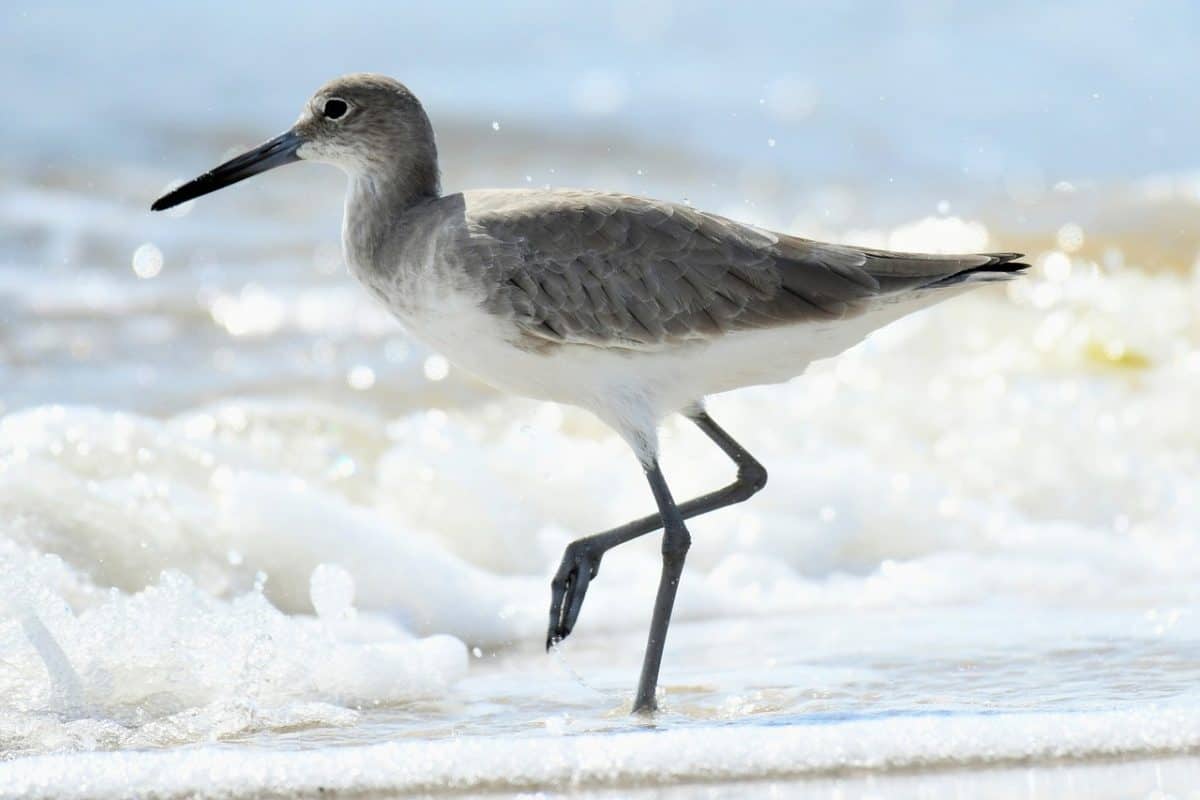
Look for these Alabama shore birds wading at the very edge of the waves crashing onto the shores of Alabama Gulf Coast beaches. They tend to arrive in Alabama when the human snowbirds do, so watch for them in the late fall, winter, and early spring.

Snowy Plover
With soft white feathers that live up to its name, the snowy plover can be seen along the Gulf Coast’s sandy beaches, tidal flats, and sand bars. Snowy plovers dine on small marine creatures, typically spotting its prey and then running to pounce on it.
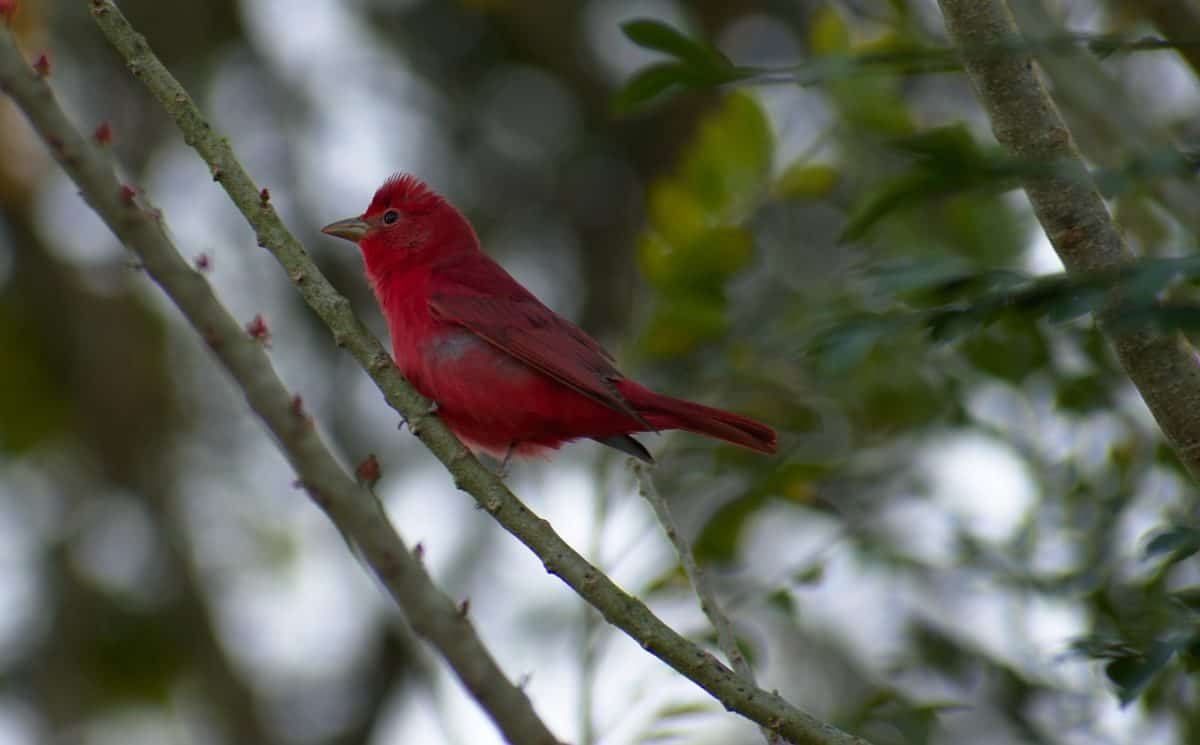
Summer Tanager
At first glance, bird watchers may mistake this scarlet songbird for a cardinal. But a second glance at the black accents on its wings and missing mohawkish crest quickly confirm that the tanager is the cardinal’s cousin rather than twin. Look for these songbirds in the wooded areas of southern Alabama where they happily hunt for insects, especially wasps.

Terns Like Least Terns, Royal Terns, and Sandwich Terns
The birds that make up this category of seabirds are most commonly spotted by water where they dine on fish and crustaceans, especially shrimp. Along Alabaman’s Gulf Coast, look for least terns, royal terns, and sandwich terns, all of which are most commonly seen in the spring, summer, and fall. To me, all three types of terns look remarkably similar with soft white breasts, smokey wings, and a masked-bandit-like face. However, an ornithologist could successfully identify each variation in a police line-up.

Tufted Titmouse
Along with cardinals, doves, and ducks, I regularly spot tufted titmice in my backyard bird feeder here in the Midwest. However, seeing these birds that look a bit like permanently adolescent blue jays along the Alabama bird trail is always a treat. A member of the same bird family as chickadees, tufted titmice are found in wooded areas and backyards in Alabama just like they are in most states east of the Rocky Mountains.
Fun Fact: There seems to be a spirited online debate about whether the plural of titmouse is titmouses or titmice. Because the head of my editorial board (who is also my mother) recommended titmice, I’m using that plural form here. After all, I’ve made it far enough in this life to know that my mother was right about everything! (And I wanted to point that out in case my children read this…)

Turkey Vulture
From Snow White to the Jungle Book to the Lion King, even animated vultures freak me the heck out. And seeing them in real life totally gives me the heebie jeebies, even if it’s warm and sunny in Alabama and I can hear the sound of the waves hitting the beach.
Fun Fact: In the United States, when someone refers to a buzzard, they mean a turkey vulture. This fun fact will come in handy in the woodpecker section below.
These scavengers like to feast on everything from roadkill to fish that have washed up on the banks of rivers, ponds, or the beach. So, while you may want to see one to check it off your bucket list of birds in Alabama, be forewarned that you may not want to watch it eat dinner.

Warblers
There are more warblers in Alabama than there are letters in the alphabet! So keep an eye out for blue-winged warblers, pine warblers, wood warblers, yellow-rumped warblers, and many other bright beautiful birds when exploring the Alabama birding trail!
Part of the Parulidae family of birds (which I’m pretty sure is Latin for “particularly pretty”), warblers are often called “butterflies of the bird world” due to their delicate build and bright colors. Look for warblers with feathers that range from sunny yellow to pumpkin orange to sky blue.
Listen for the warbler song in open fields and wooded areas in Alabama which sounds like “sweet sweet sweet I’m so sweet.”

Woodpeckers
While animated buzzards still freak me out as an adult, I always loved Woody Woodpecker. And, it’s not just because he regularly outsmarted creepy Buzz Buzzard. Whether the real life woodpecker is a red-bellied woodpecker (sporting a red belly) or a red-headed woodpecker (like Woody), they’re always cool to watch. The red-bellied woodpecker is the most common woodpecker species in Alabama, so keep an eye out for a shock of bright red “hair” when you explore the Alabama bird trail.
Fun Fact: The Northern flicker is a member of the woodpecker family and the Alabama state bird. Because of that honor, the Northern flicker is often called the yellow hammer. However, the Northern flicker is not tied to the Alabama nickname, The Yellowhammer State. Instead, the nickname is a Civil War reference related to yellow trim on the Confederate soldiers’ uniforms.
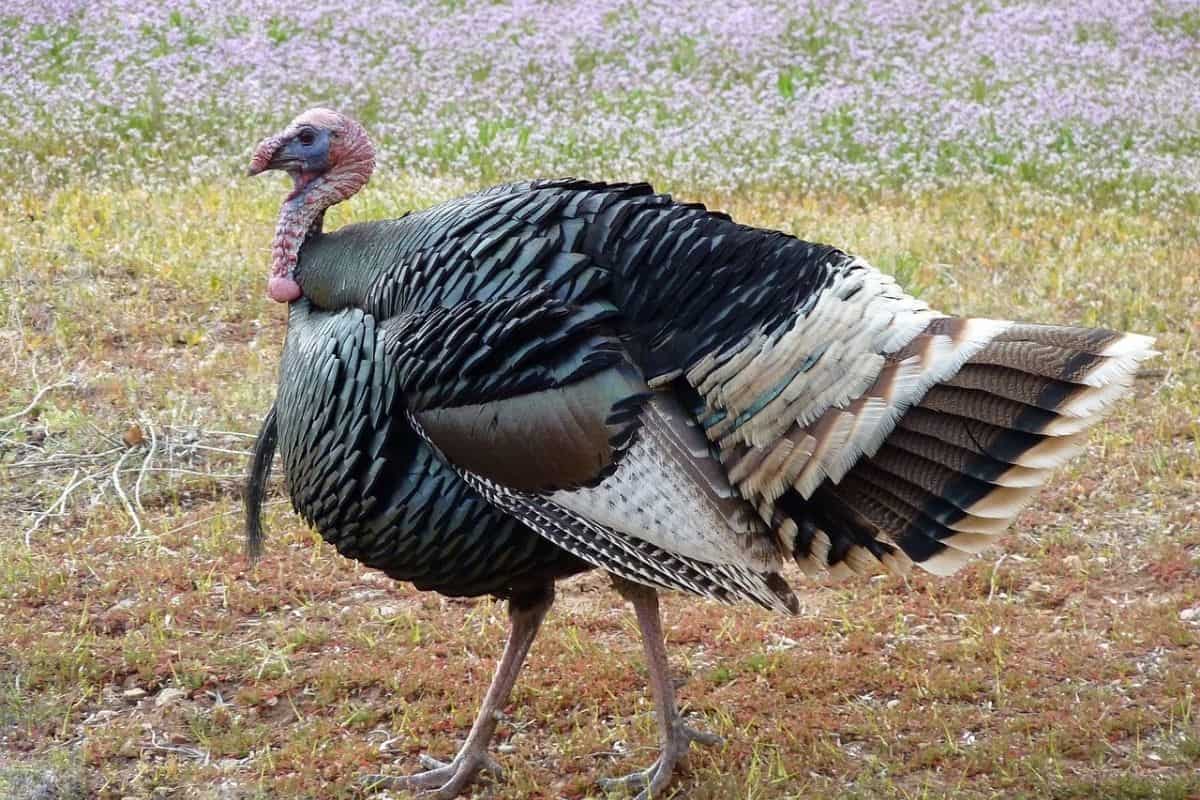
Wild Turkey
Although they don’t look that different from turkey vultures, wild turkeys are nowhere near as creepy as this feathered friend that shares a similar name. Look for these woodland birds in Alabama’s treed areas where they enjoy acorns, beechnuts, dogwood berries, and other items from the forest floor.
Have You Watched for Birds Along the Alabama Bird Trail?
What kinds of birds did you see along Alabama’s Gulf Coast? Where did you spot the birds you saw? Any additional tips or tricks to pass along? Share your experiences in the comments section below.

Looking for more information to plan your Alabama vacation? Check out my additional recommendations to help you plan your trip to Alabama, including what to see and do in Alabama, the best places to stay in Alabama, where to eat in Alabama, and more!
Ready to Go?
Use These Helpful Links to Book Your Trip!
- Find low fares with airfarewatchdog and Skyscanner
- Book your plane ticket with Expedia or Kayak
- Or take the scenic route on an epic road trip in a rental car or an RV from Outdoorsy
- From hotels to private homes, find the perfect accommodation with Hotels.com or Vrbo
- Travel in style with a suitcase, carry-on, backpack, or handbag from eBags
- Save on tickets to attractions, sightseeing tours, and more with CityPASS, Tiqets, and Viator
- Don’t leave home without travel insurance from AXA
- Discover the sights, history, and culture of your destination with an interactive scavenger hunt
- Need something else to plan your perfect trip? Visit my travel resources page for more trusted partners. Happy wandering!
Thank you for sharing!




Living in the PNW where we have so many birds migrate through, I’ve learned more about birds and so enjoy seeing them. We have barred owls here, but I didn’t realize they had brown eyes, while most others have yellow. Alabama has quite a count and so many beautiful birds. I’d love to check out all the birds there, and especially see at Roseate Spoonbill!
As many times as I’ve been to Alabama I don’t think I have ever paid attention to the birds. That’s a great list, I’ll have to do a bit of bird watching next time I’m in the area.
And now you have a secret decoder ring to help you tell the difference between a cardinal and a summer tanager! 🙂
I am from Alabama and I did do a bird trail a long time ago as a kid, but I haven’t done it recently. I had no idea the blue jay is part of the crow family and the blue-gray gnatcatcher is absolutely gorgeous! I also had no idea we had wood ducks in Alabama. They are so colorful! I want to do a bird photography tour now!
Oh, Alabama. That state REALLY stole my heart! Then again, it’s really hard for a gal living in the most landlocked city in the nation not to fall in love with any place that’s coastal (and affordable at the same time). I want to go back and explore Mobile, Montgomery, and Birmingham. You know, just for starters!
Stunning bird photos. My two favourites are the Willets and Blue-gray gnatcatchers. There is such an interesting array of different birds in Alabama.
Yes, there are, and I had no idea until we visited!
Fabulous article! We love birdwatching and in fact just photographed some wild turkeys this morning.
How cool is that? We have a flock that runs through our neighborhood, but I never seem to be set up to photograph them when I see them.
If you like this you should also check out Beaumont, Texas, which is on two migratory flyways!
Oooooh, I bet I’d love it! Thanks for the tip!
Wow amazing variety of birds there! I have taken pictures of few of these in a bird sanctuary here. Alabama Bird Trail is a real treat for bird lovers.
Who knew there were so many different types of birds in Alabama! They are all so diverse and beautiful.
This is a really great post, thank you for sharing! And you have some really beautiful images.
Happy New years from Stockholm Sweden 🙂